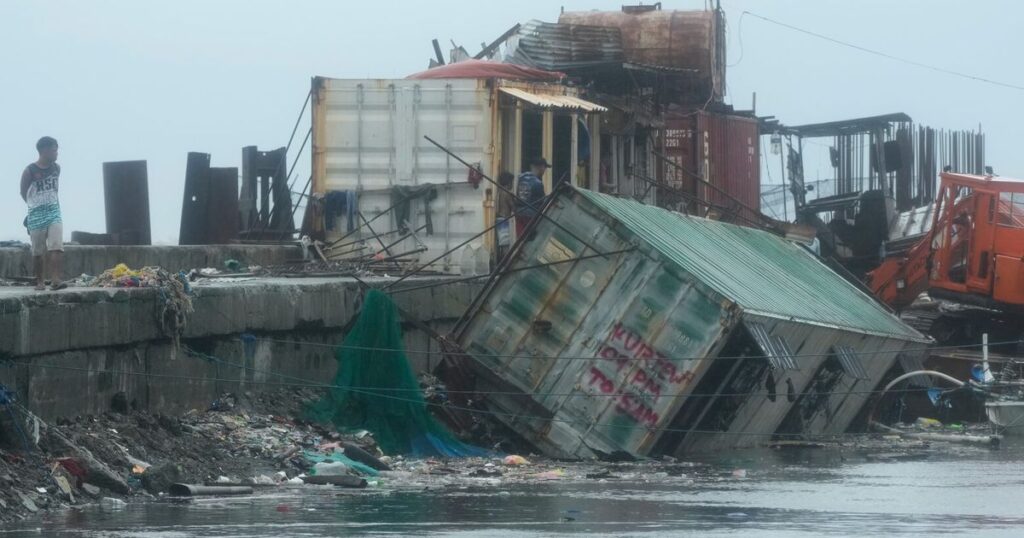MANILA, Philippines — High waves whipped up by Typhoon Fung-wong swamped Sinbanali, a seaside village near the Philippine capital of Manila, forcing residents to flee their homes amid torrential rain.
Ivy Villamor said the storm’s menacing howls, plus images of destruction caused by Typhoon Kalmaegi just last week, paralyzed her with fear.
“We did not want to be swept to sea, so we rushed here,” she said over an “evacuation breakfast” of instant noodles, hot dogs and eggs provided by the city of Bacoor. “The winds howled, and the rains were nonstop. Like it was the end of the world.”
She described the noise as “probably louder than an airplane.”
Villamor, 34, shared her meal with her 11-year-old daughter Nicole, who said that her father, Jayson, went back home to check if their hut was still standing. They were among the nearly 1,000 villagers who had rushed to Bacoor Elementary School, which serves as an evacuation center, on Sunday night.
Categorized as a super typhoon by the state weather bureau, Fung-wong made landfall Sunday evening in Aurora province, on the country’s main island of Luzon.
Authorities had already preemptively moved 1.3 million people out of harm’s way, with President Ferdinand Marcos Jr. directly appealing to the residents to follow emergency protocols.
Perhaps because of this, Fung-wong’s death toll of two was significantly lower than that of Kalmaegi, which killed more than 200 people earlier this month. Still, about 1,000 homes had been damaged by Fung-wong, said the Office of Civil Defense deputy administrator, Bernardino Rafaelito Alejandro IV.
Jessica Amposta said she did not wait for village elders to call for an evacuation plan. She and her partner, Richard Marivelez, a construction worker, bundled up their children, ages 5 to 9, before the storm’s landfall.
“We’re used to it. This is a bad cycle of events for us,” Amposta said, recalling that the family had been evacuated three times in the past year. “The heavy rains were scary. The water rose quickly, and the monitors said it was waist-deep in our home in a matter of hours.”
“I just prayed and prayed. But we are still luckier than Cebu, because we are alive,” Amposta said, referring to another part of the Philippines that Kalmaegi pummeled with deadly flooding.
Analyn Benairez, 25, was initially reluctant to evacuate.
“We held out as long as we could. But when the rains did not cease, we just had to,” Benairez said, clutching a small backpack that contained her 4-year-old son’s clothes. “At first, we didn’t want to leave, but we remembered what happened in Cebu. I thought of my son. If the waters come, we’re in trouble because none of us know how to swim.”
Her husband Jerome, who was recently let go from his job as a bus conductor, said they had prepared as much as they could, and listened to local authorities who had traveled around the area a day before Fung-wong made landfall.
By the time they evacuated, he said, the waters had already reached his waist, but were receding. “Hopefully, we’ll be home later and begin cleaning our home,” he said. Alejandro, the civil defense official, said 132 villages had been flooded. “There have been reported storm surges in coastal communities, then a number of landslides,” he added.
Some areas in Aurora province remain “isolated due to landslides,” he said, but added that cleanup work would happen immediately.
He said the government had deployed nearly 1,000 search-and-rescue teams in anticipation of Fung-wong, the 21st storm to hit the Philippines this year.
“While Typhoon Uwan has exited our landmass, it will continue to bring rains to Luzon, and our operations to help local government units and their constituents continue,” he said, using the Philippine name for the storm. He added that there was “still danger” in certain areas.

